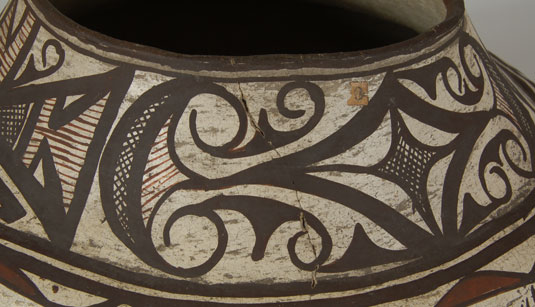Zuni Pueblo 19th Century Olla [R]
+ Add to my watchlist Forward to Friend
Forward to Friend
- Category: Historic
- Origin: Zuni Pueblo, SHE-WE-NA
- Medium: clay, pigment
- Size: 11” tall x 13-1/8” diameter
- Item # C3585
- Price No Longer Available
Assigning a date to Zuni Pueblo historic pottery is facilitated by the very large number of Zuni vessels collected for the Bureau of American Ethnology between 1879 and 1885 and those collected for the American Museum of Natural History between 1899 and 1912.
Shortly before 1870, a change began to be implemented by potters to paint the interior of the neck and the underbody black. In early cases, black was applied over the former red interior neck paint. In those vessels, the red is faintly visible through the black. Of course, a change of this nature did not occur overnight but may have occurred over a decade or several decades. It is believed that the change on the neck interior was completed by 1865 and on the underbody color not until 1900.
The very pronounced puki flexure on earlier Zuni jars greatly decreased over time to a less pronounced one. Puki lines are noticeable as late as 1920 but not afterwards.
Zuni jars made after 1850 display a more elaborate design on the body and a more repetitive design on the neck. The body design starting around 1870 features two large design panels in a horizontal layout and two smaller panels in a vertical layout. The larger panels were divided in half by a horizontal band containing simple birds with elaborate tails. Above and below the birds were floral-like designs or, in some cases, deer. The vertical panels featured non-plant and non-animal designs such as volutes or arrowheads.
Neckband designs on Zuni Polychrome jars seem to be standard over decades with very little freedom for the potter to innovate. Double ended scrolls and a dagger element predominate.
Based on these and other documented designs, it is determined that this large Zuni Polychrome jar dates to the 1870s. The interior neck appears to consist of black paint over red paint, the underbody is black and there is a definite, although not too pronounced, puki flexure. The design is separated into neck and body, with the body consisting of deer in feather houses below which are deer enclosed by feather crooks. Between the upper and lower deer is a band of red birds with beautiful flowing elaborate tails. There is no black outlining on the birds.
The vertical panels on the body have a circle outlined by black caps and above and below the circle are dagger-type elements in heavy black outlining and fine red lines and cross hatches in the interior.
Condition: very good condition with a stabilized hairline rim crack that has not been concealed by overpainting. The jar is in very stable condition.
Provenance: from the collection of a New York resident.
Reference and Recommended Reading: The Pottery of Zuni Pueblo by Lanmon and Harlow, 2008. This 604-page book is the authoritative publication on Zuni pottery and consistently used by us for reference.

- Category: Historic
- Origin: Zuni Pueblo, SHE-WE-NA
- Medium: clay, pigment
- Size: 11” tall x 13-1/8” diameter
- Item # C3585
- Price No Longer Available



